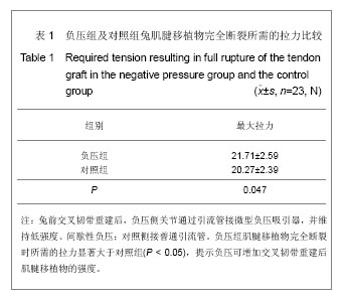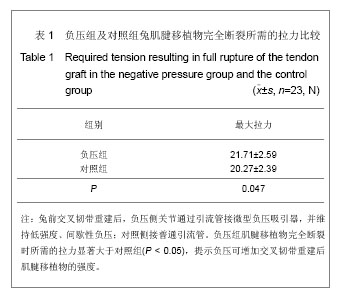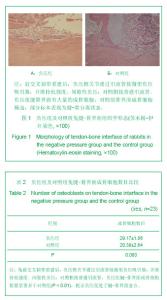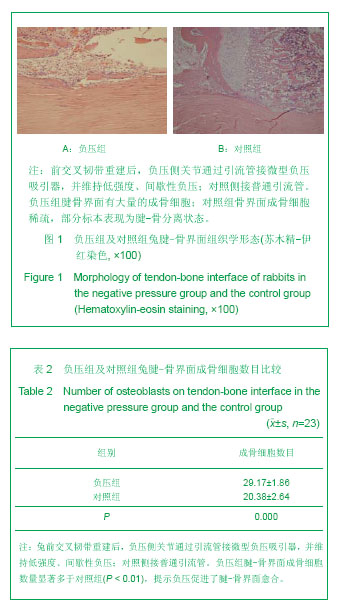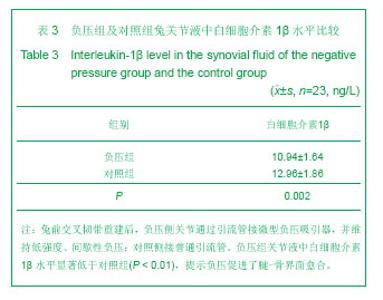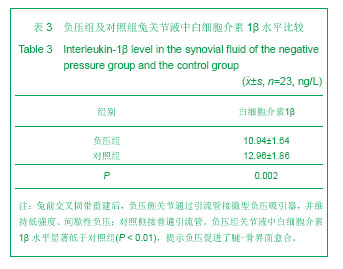| [1] |
Liu Shaohua, Zhou Guanming, Chen Xicong, Xiao Keming, Cai Jian, Liu Xiaofang.
Influence of anterior cruciate ligament defect on the mid-term outcome of fixed-bearing unicompartmental knee arthroplasty
[J]. Chinese Journal of Tissue Engineering Research, 2021, 25(6): 860-865.
|
| [2] |
Ma Ziyue, Ju Xiaochen, Zhang Lei, Sun Rongxin.
Tendon-bone healing in anterior cruciate ligament reconstruction with and without remnant preservation
[J]. Chinese Journal of Tissue Engineering Research, 2021, 25(4): 582-587.
|
| [3] |
Sun Jianwei, Yang Xinming, Zhang Ying.
Effect of montelukast combined with bone marrow mesenchymal stem cell transplantation on spinal cord injury in rat models
[J]. Chinese Journal of Tissue Engineering Research, 2021, 25(25): 3962-3969.
|
| [4] |
Xiong Xiaolong, Wang Guangji, Fang Yehan, Du Xiufan, Hang Hui, Ye Zhifang.
Meta-analysis of comparison of the effect of tibial fixation using absorbable screws and metal screws in anterior cruciate ligament reconstruction with autologous hamstrings
[J]. Chinese Journal of Tissue Engineering Research, 2021, 25(21): 3438-3444.
|
| [5] |
Lu Mingfeng, Zhao Lilian, Xing Jisi, He Lilei, Xu Ting, Wang Changbing.
Posttraumatic progression of cartilage degeneration following anterior cruciate ligament reconstruction: a second-look arthroscopic analysis
[J]. Chinese Journal of Tissue Engineering Research, 2021, 25(2): 222-227.
|
| [6] |
Zheng Weipeng, Wei Hewei, Liu Zhijun, Wan Lei, Chen Sheng, Liao Zhihao, Hu Weijian.
Application of three-dimensional reconstructive CT versus X-ray in postoperative evaluation of bone tunnel and graft status after single bundle anterior cruciate ligament near-isometric reconstruction
[J]. Chinese Journal of Tissue Engineering Research, 2021, 25(18): 2881-2886.
|
| [7] |
Sun Kai, Chen Lei, Mai Yao, Hu Hua, Chen Liang, Zhong Jun, Hu Yong, Qiu Bo.
Clinical application of enhanced recovery after surgery in the perioperative period of anterior cruciate ligament reconstruction
[J]. Chinese Journal of Tissue Engineering Research, 2021, 25(11): 1647-1651.
|
| [8] |
Li Shanghua, Wang Haiyan.
Biomechanics of lower extremities from straight forward to
side-step cutting
[J]. Chinese Journal of Tissue Engineering Research, 2020, 24(8): 1260-1266.
|
| [9] |
Chen Wei, Zou Gang, Liu Yi.
Clinical application and focus of LARS ligament in anterior cruciate
ligament reconstruction
[J]. Chinese Journal of Tissue Engineering Research, 2020, 24(8): 1287-1292.
|
| [10] |
Ma Zhigang, Guo Liping, Zhang Jianning, Li Yonggang.
Changes in related factors in synovial fluid of
osteoarthritis rabbits after treatment with different molecular weights of
sodium hyaluronate injection
[J]. Chinese Journal of Tissue Engineering Research, 2020, 24(5): 694-698.
|
| [11] |
Shi Weifa, Guo Zhimin, Deng Huiyun, Shen Yanling, Shi Lingling, Wu Shilong, Huang Zebin.
Systematic evaluation of anterior cruciate ligament
reconstruction with peroneus longus tendon and hamstring tendon
[J]. Chinese Journal of Tissue Engineering Research, 2020, 24(5): 811-820.
|
| [12] |
Zou Haibo, Sun Xiaofeng.
Variation of Fas/Fasl pathway in limb ischemia-reperfusion lung injury rats after etomidate post-treatment
[J]. Chinese Journal of Tissue Engineering Research, 2020, 24(32): 5162-5167.
|
| [13] |
Zhang Bin, Dai Fenglei, Yin Hong, Zeng Yi, He Qiang, Qian Jianji, Ou Xianfeng.
Effect of catalpol from the root of Rehmannia glutinosa on the expression of inflammatory proteins in synovium of the knee joint in rats with early osteoarthritis
[J]. Chinese Journal of Tissue Engineering Research, 2020, 24(29): 4656-4661.
|
| [14] |
Huang Junhan, Chen Ping, Liu Jun, Chen Haiyun, Pan Jianke, Lü Yang, He Xiangzhong.
Efficacy of platelet-rich plasma in arthroscopic anterior cruciate ligament reconstruction: a meta-analysis
[J]. Chinese Journal of Tissue Engineering Research, 2020, 24(29): 4737-4743.
|
| [15] |
Yang Fan, Liu Baoyi, Cao Meng, Zhu Xiaoshu, Zhang Yu, Qin Kairong, Zhao Dewei.
Basic fibroblast growth factors protect chondrocytes by
antagonizing extracellular inflammatory factors
[J]. Chinese Journal of Tissue Engineering Research, 2020, 24(23): 3621-3626.
|
